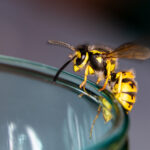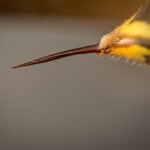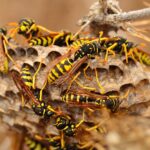How Can We Help?
Where do wasps build their nests?
Wasps build their nests in various spots, often picking sheltered areas that protect them from the weather and  predators. Common places include the eaves, soffits, and attics of buildings since these areas offer both shelter and easy outdoor access. Wasps also like to build nests in trees, shrubs, and bushes where the foliage adds extra cover. Some species, like yellow jackets, might even go for underground nests, using old rodent burrows or other holes.
predators. Common places include the eaves, soffits, and attics of buildings since these areas offer both shelter and easy outdoor access. Wasps also like to build nests in trees, shrubs, and bushes where the foliage adds extra cover. Some species, like yellow jackets, might even go for underground nests, using old rodent burrows or other holes.
You can also find wasps nesting in wall voids, behind siding, and under decks or porches. These spaces provide a safe environment for the colony to grow. Wasps might also use human-made structures like sheds, garages, and outdoor furniture, making the most of any gaps or crevices.
Paper wasps often build nests in exposed places, like hanging from branches or structures, creating those familiar umbrella-shaped nests made from chewed wood fibers mixed with saliva. On the other hand, hornets usually create larger, more enclosed nests that are often spherical and can be found in similar locations.
The choice of nesting site depends on the wasp species and what's available. No matter where they decide to nest, wasp nests can be a hassle and pose a safety risk, especially if they're near areas with a lot of human activity.
What are the different types of wasp nests?
Wasp nests come in all sizes and shapes, depending on the species, each with its own unique style and construction method. Paper wasps, for instance, make open, umbrella-shaped nests from chewed wood fibers mixed with saliva, creating a papery material. These nests have visible hexagonal cells and usually hang from eaves, branches, or other horizontal surfaces.
Hornets, on the other hand, build bigger, enclosed nests that are often spherical or teardrop-shaped. Made from the same papery stuff, these nests have a protective outer layer hiding multiple internal combs. You can often spot hornet nests in trees, shrubs, or attached to buildings, sheltering their large colonies.
Yellow jackets are famous for their underground nests, often taking over abandoned rodent burrows or other underground spaces. They have extensive networks of tunnels and chambers. However, yellow jackets can also make aerial nests, similar to hornets, in wall voids, attics, or other protected areas.
underground spaces. They have extensive networks of tunnels and chambers. However, yellow jackets can also make aerial nests, similar to hornets, in wall voids, attics, or other protected areas.
Mud daubers, another type of wasp, build small, tube-like nests from mud. You'll typically find these nests on walls, under eaves, or in sheltered outdoor locations. Mud daubers' nests are solitary and used to house their larvae.
Each type of wasp nest reflects the species' behavior, habitat preferences, and colony structure, from the open and visible nests of paper wasps to the hidden, intricate nests of yellow jackets and hornets.
How do wasps defend their nests?
Wasps are pretty serious about defending their nests, using both their physical skills and chemical defenses to protect their colonies. When their nest is threatened, they release alarm pheromones to alert members of the colony, leading to a coordinated defense. Wasps have stingers to inject venom into intruders or threats. Unlike bees, many wasp species can sting multiple times, making them particularly tough opponents.
Besides stinging, wasps might also bite or grapple with intruders using their mandibles. They can swarm in large numbers around the nest, acting as a strong deterrent to potential threats. Species like yellow jackets and hornets are notorious for their aggressive behavior and might attack in large groups if their nest is disturbed.
Wasps defend their nests vigorously because they contain the eggs, larvae, and pupae crucial for the colony's survival and growth. Protecting the nest ensures the continuation of the species and the colony's ability to thrive. Encounters with defensive wasps can be risky, especially for people allergic to stings, so it's important to be cautious and call in professionals when dealing with wasp nests.
Do wasps reuse old nests?
Wasps usually don't reuse old nests. Most wasp species start fresh each season, leaving their old nests behind when the colony dies off in the autumn or winter. The queen, after mating in late summer or early autumn, will spend the winter in a sheltered spot and begin building a new nest in the spring. This new nest is made from scratch using chewed wood fibers mixed with saliva to create a papery substance.
Old nests are generally left to fall apart and are rarely reused by new wasp colonies. This is because old nests might have compromised structural integrity and could harbor parasites, predators, or diseases that pose risks to the new colony. Plus, weather can degrade the nest, making it unsuitable for reuse.
 However, some species, like certain paper wasps, might build new nests in the same area or even next to old ones, taking advantage of a proven location that offers protection and resources. Still, each new colony constructs its own nest to ensure it's clean, sturdy, and free from the previous year's leftovers. If you suspect a wasp infestation or any pest problems, feel free to contact us for a safe and efficient removal.
However, some species, like certain paper wasps, might build new nests in the same area or even next to old ones, taking advantage of a proven location that offers protection and resources. Still, each new colony constructs its own nest to ensure it's clean, sturdy, and free from the previous year's leftovers. If you suspect a wasp infestation or any pest problems, feel free to contact us for a safe and efficient removal.
